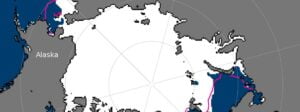Arctic sea ice extent above levels not seen since 2013
Arctic’s seasonal sea ice loss began more slowly in May 2022 than in the recent years as air temperatures were closer to the 1981 to 2010 average. The month ended with the highest sea ice extent since 2013 – the 14th lowest in the satellite record.

